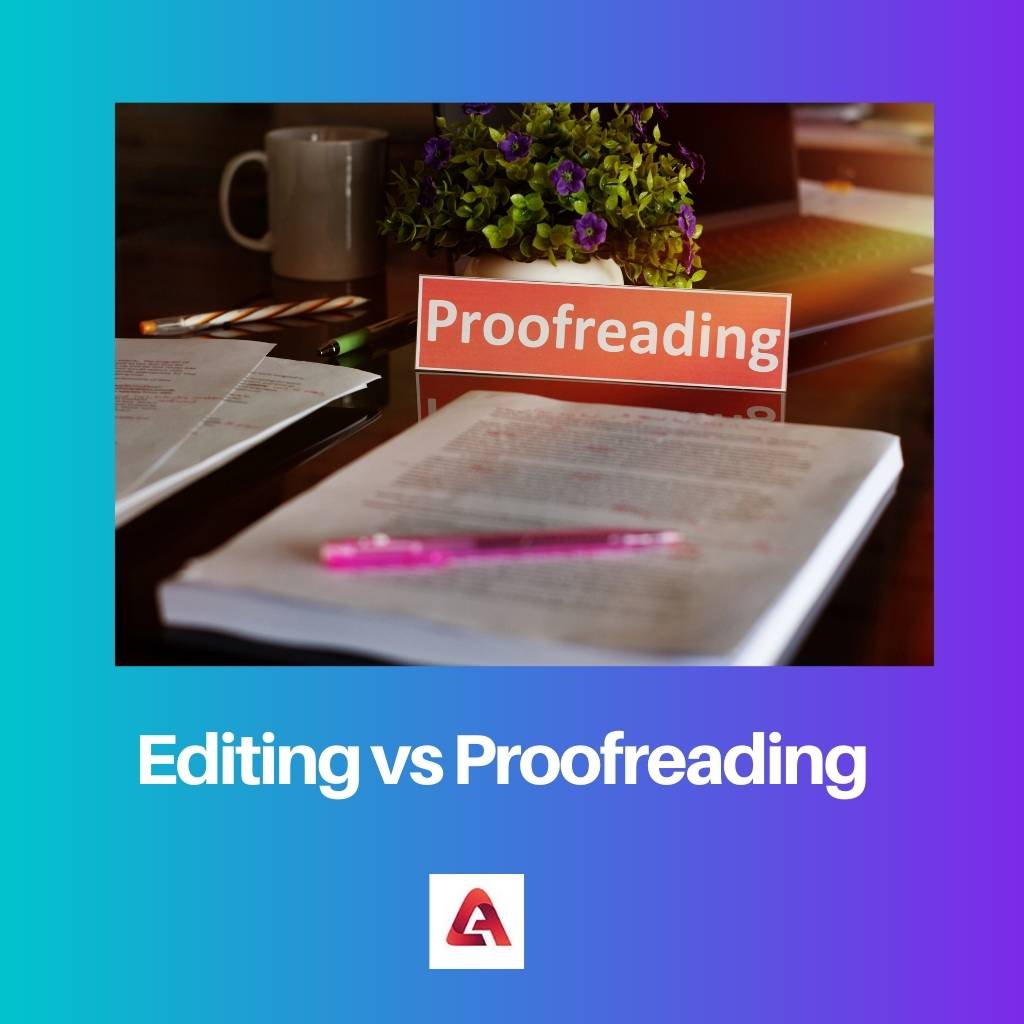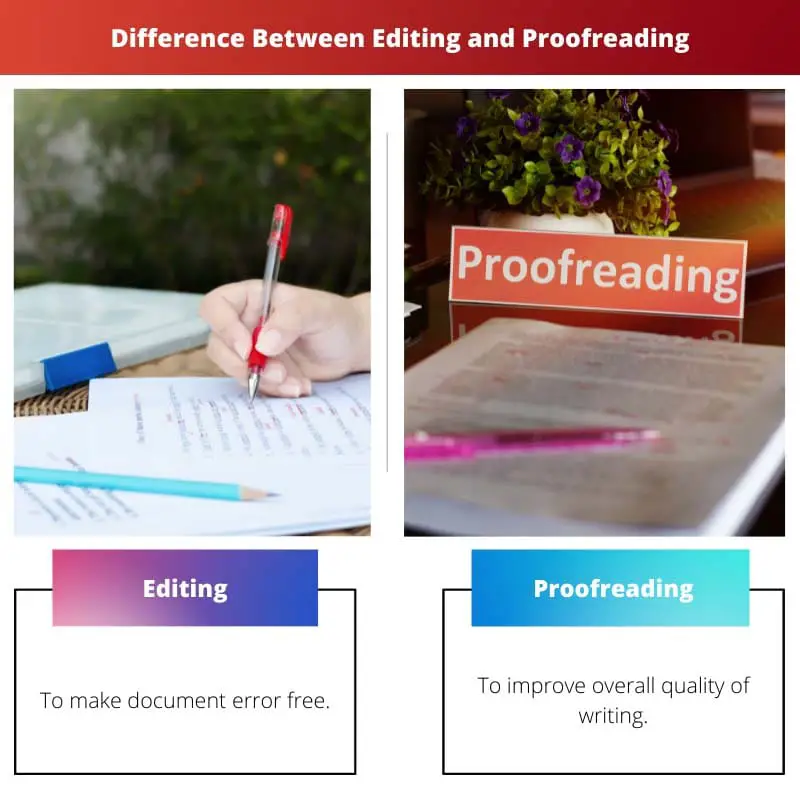The term “document” stands for a piece of writing which provides information. While preparing a document, we have to go through different stages, including editing and proofreading.
At the stage of editing, the main aim is to make sure everything flows correctly. On the other hand, proofreading comes in the last stage while processing a document.
Key Takeaways
- Editing focuses on improving a text’s overall structure, clarity, and coherence, addressing content and organization.
- Proofreading involves checking for grammar, punctuation, spelling errors, and formatting inconsistencies.
- Both editing and proofreading are essential for producing polished, professional, and error-free documents.
Editing vs Proofreading
The difference between proofreading and editing is that the latter looks to correct issues that are at the core of writing, whereas proofreading is the final check of any document. Proofreading is done to check spelling, grammatical accuracy, and if the syntax is in order or not in a document. While doing editing, you have to look at the document as a whole.

Editing involves checking the document structure for its continuity and has to go for factual accuracy. It mainly addresses the core features of writing, such as sentence construction and language clarity.
Editing helps to improve the clarity, readability, and tone of the text. It may also require removing, changing or adding text in order to make a document clearer.
Proofreading eliminates grammatical and punctuation errors, misspellings, formatting errors, inconsistencies, etc. It makes any written work perfect. That’s why it is done just before publishing the document or performed as a final check on a document.
Its main aim is to make the written work free from errors which improves the overall quality of a written work in order to make it clearer and simpler.
Comparison Table
| Parameters of comparison | Editing | Proofreading |
|---|---|---|
| Motive | To make document error free. | To improve overall quality of writing. |
| Stage | After early draft of the document such as writing. | Performed just before publishing the document. |
| Word count reduction | It includes, if required. | It does not require. |
| Time | Take slightly longer period of time. | Can be done in shorter period of time. |
| Cost | Have to pay more than you would for proofreading. | It is quite inexpensive. |
What is Editing?
Editing can be considered an art because its main aim is to improve the quality of any written piece of work by enhancing the language and making changes for readability, flow, and clarity.
After editing, the language becomes sharp and consistent as well as the expression becomes clear and readable.
Proofreading can be included in the editing, spelling, grammar and other errors are eliminated at that stage. While editing a text, you have to look at the document as a whole and have to ensure that the information which is included in a document is accurate.
As a result, it involves a lot of research which is much more time-consuming.
Editing involves an editor making changes and suggestions for the document. An editor should be familiar with the conventions and rules of English.
An editor’s main job is to scrutinize and polish the written material for a smooth narration. He should be in collaboration with the editor to polish and refine any written piece of work.
There is a need to ensure quality writing, as the higher the standard of written work, the clearer and more authoritative the author will sound.
It does not matter how much brilliant your idea and logic if writing is not good in terms of fluency, consistency, and mistake-free, it is useless.

What is proofreading?
Proofreading can be considered a science because it identifies all errors, including spelling, punctuation, and grammar. It tends to be a more straightforward exercise than editing as it addresses surface-level issues, hence, it is less time-consuming and much cheaper than editing.
Proofreading is important as any document which is going to be published should be in the clearest possible way. It can be clear only when there are no grammar, spelling, or punctuation errors, as it can impact the written work because no one wants even a minor mistake on their document.
Proofreading is a skill that requires knowledge of the English language and the ability to concentrate, as it is important to correct even small errors in the text.
It can be possible that the editor may have missed out on formatting issues or grammatical to prevent this proofreader gives the text a final touch by correcting it.
Proofreading helps to polish the document; that’s why this step comes at the very last stage of preparing any document. Proofreading compares the final document to the edited document to make it clearer.
This process can be called the last line of defence for any document because it makes the overall document presentable with no errors.

Main Difference Between Editing and Proofreading
- Editing is done to maximize the effect of the written piece. In contrast, proofreading is important to produce a good document that is free from errors and poor grammar.
- Editing is required when there is a need for revision for readability, flow, and clarity. On the other hand, proofreading is required to check the basic grammar of any document.
- When it comes to collaboration, the editor requires to work with the author, whereas the proofreader does not require collaboration with the author at all.
- While editing any document, it depends on the written work if it requires very little work or a lot of work. But the proofreader’s main job is to compare the final document to the edited draft.
- The editor looks for facts to check if the information is accurate for the document, but the proofreader looks for the final polish of the text, such as spelling and grammatical accuracy.

- http://www.mariapinto.es/ciberabstracts/Articulos/furuta.pdf
- https://www.pnas.org/content/71/10/4135.short

The distinction between editing and proofreading is well articulated in this article. It’s important to recognize the unique aspects of each process.
Indeed. The article provides a comprehensive understanding of editing and proofreading, which is essential for writers and editors alike.
I fully agree. The level of detail in explaining the differences between editing and proofreading is highly valuable.
The article clearly outlines the differences between editing and proofreading, providing a detailed comparison of their distinctive functions in the writing process.
The article effectively distinguishes between editing and proofreading, emphasizing their respective roles in the document preparation process.
I fully agree. Understanding the nuances of editing and proofreading is essential for achieving professional, high-quality written work.
I could not agree more with the importance of proofreading. It is essential to make sure that there are no grammar, spelling, or punctuation errors in a document before publishing.
Absolutely. Proofreading should always be the last step in the document preparation process.
It’s interesting how this article highlights the difference between editing and proofreading. They each offer unique contributions to the writing process.
That’s a great point. I found the comparison table particularly useful in understanding these distinctions.
Indeed, understanding the specific function of editing and proofreading is crucial for creating high-quality written work.
The role of editing in improving the language, readability, and tone of a text is extremely important. The article effectively conveys the significance of this process.
I couldn’t agree more. I particularly appreciate the focus on the art of editing and its impact on the quality of writing.
The importance of quality writing and the role of both editing and proofreading in achieving it are highlighted excellently in this article.
I couldn’t agree more. The emphasis on achieving error-free and polished written work is well articulated in this piece.
Absolutely. The emphasis on the quality of writing through the editing and proofreading processes is crucial for producing clear and authoritative documents.
The explanation of what editing and proofreading involve is both comprehensive and insightful. Recognizing these distinctions is crucial for producing high-quality written work.
Absolutely. The article effectively captures the importance of these processes in the document preparation.
This article provides a clear overview of what is involved in both editing and proofreading. The comparison table helps outline the differences between the two processes effectively.
Absolutely. Understanding how editing and proofreading differ is critical for producing well-crafted documents.
The explanation of what editing and proofreading involve is quite thorough. It’s essential to recognize that both stages are necessary for achieving polished, professional documents.
I appreciate the emphasis on how editing and proofreading contribute to the overall quality and clarity of written work.
I absolutely agree. The way the article clarifies these concepts is very informative and helpful.